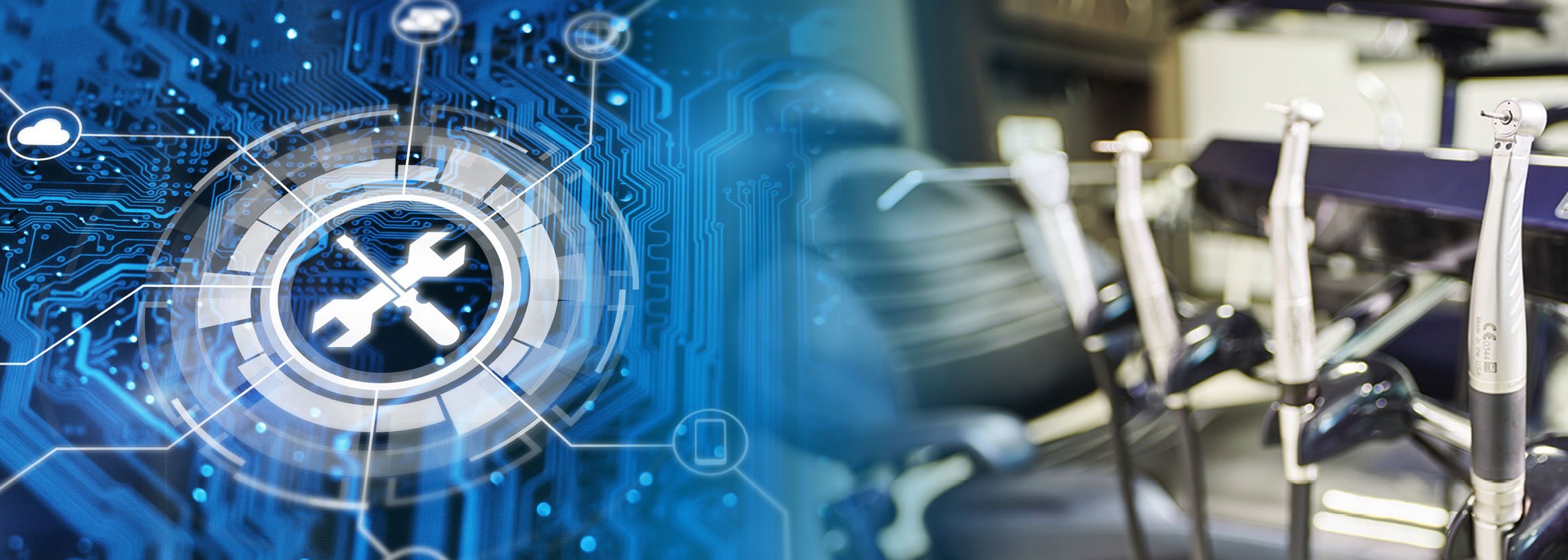
All dentists know that a substantial investment is required to equip practices with state-of-the-art tools and technologies. From chairside units in the treatment room to precision instruments in the surgical suite, each piece of equipment plays a pivotal role in delivering quality patient care.
However, without a focus on preventative maintenance for dental equipment, even the most advanced machinery can succumb to wear and tear, leading to costly downtime and issues like biofilm buildup that have the potential to cause harm to patients and damage to your practice’s reputation.
In this article, we’ll delve into the essential steps for establishing a robust dental equipment maintenance regimen for your operatory/treatment room, surgical suite, and hygiene room. By adopting a comprehensive plan, you’ll ensure your equipment continues to function at peak performance, safeguarding your assets and maintaining the trust of your valued patients.
General Maintenance Practices
In general, there are several key areas of focus for good preventive maintenance for dental equipment: proper cleaning; storage and handling; and routine inspections. While these general guidelines can be helpful, it’s important to consult the instruction and maintenance manuals of all your practice’s equipment. Following the specific recommendations for each type of equipment will ensure that the appropriate products and methods are used to keep your equipment running smoothly and safely for its entire lifespan.
Cleaning Techniques for Longevity
Cleaning, by properly removing organic and inorganic debris from equipment before sterilization, is a key first step for tools and equipment in the treatment room. Follow the CDC’s guidance on proper cleaning of dental instruments when considering cleaning methods such as automated cleaning devices or manual methods. You can learn more about proper cleaning and maintenance of handpieces in our recent article.
For equipment like cabinets and delivery units, a weekly wash with mild soap and water is appropriate. When considering premoistened wipes, use only the types recommended by manufacturers. In general, alcohol-based products are excellent alternatives to products that contain hydrogen peroxide or other substances that can dry out soft equipment like upholstery and plastic.
Proper Storage and Handling
When thinking about dental equipment maintenance, it’s important to consider the proper storage and handling of all instruments and other equipment, including climate control for treatment and storage spaces in your office. When planning for storage, consider the climate of your practice location, along with specific recommendations from your equipment technicians and the manufacturer’s instructions for use.
Routine Equipment Inspections
Routine equipment inspections are a vital part of your dental maintenance routine. Here are some key inspection activities:
- O rings and seals on handpieces should be inspected and replaced as needed.
- Staff members should inspect vacuum valves and traps at least weekly, if not daily.
- Amalgam separators should be changed when they are discolored, broken, or not working properly.
- Professional technicians should come to the practice at least once per year, if not more frequently, to make sure all equipment is running correctly.
General Maintenance Tips
We’ve compiled a general list of maintenance tasks for a typical dental office. When customizing this list for your own practice, be sure to consult the manuals for each piece of equipment, along with regulations in your location.
Water Lines
- Follow ADA guidelines for water quality.
- Flush lines for 20-30 seconds between patient sessions.
- Perform monthly shock treatments using a 9:1 water-chlorine solution.
- Use dental water line treatment products for daily maintenance.
- Drain the water bottle weekly or during extended periods of non-use.
- Replace water filters if water flow is impeded or sediment accumulates.
- Conduct iodine strip test annually.
Dental Unit
- Replace air and water regulator filter yearly—more frequently in areas with hard water or contamination risks.
Water Purification System
- Follow manufacturer’s recommendations for filter replacement.
- Sanitize annually with bleach.
- Address any dispenser exceeding one part per million.
Autoclave
- Drain water reservoirs at least once per week to prevent bacterial growth.
- Use a manufacturer-specified cleaner monthly.
- Reverse the gasket monthly or per manufacturer’s instructions.
- Replace sterilizer filters annually.
Handpieces
- Ensure handpieces are lubricated properly, if using lubricated handpieces.
- Change aerosol filter annually or if oil dripping occurs.
- Replace oil collection system as needed.
X-Ray Equipment
- Annually inspect equipment for functionality.
- For 3D units, conduct monthly QA tests.
- Calibrate X-ray machines annually or as prompted.
Upholstery
- Clean daily with mild cleaning agents.
- Replace upholstery or entire unit if damaged [link to https://www.dentalez.com/five-signs-its-time-to-replace-your-dental-chair/]
Amalgam Separators
- Keep vacuum lines wet by running water after each patient.
- Replace container when water reaches fill line.
Vacuum Traps
- Maintain clean vacuum traps by rinsing the lines with warm water and an enzymatic cleaner.
- Clean and lubricate vacuum valves.
Syringes
- Make sure air and water syringes are free of clogs and leaks.
- Clean or replace valves as needed.

Crafting an Effective Maintenance Checklist
In a bustling dental practice, it’s vital to maintain a seamless workflow while ensuring the longevity of equipment. A good maintenance plan includes comprehensive lists of tasks for all employees addressing cleaning, disinfection, and minor repairs. Having clear, well-structured checklists for dental equipment maintenance is indispensable for keeping dental equipment performing at its best for years to come.
Well-defined Tasks For Every Dental Practice Team Member
With high staff turnover and varying schedules, it’s imperative that each team member understands their specific tasks when it comes to equipment upkeep. Clear checklists eliminate the risk of confusion, so that no crucial task is overlooked or duplicated.
Dental assistants often play a key role in keeping equipment maintained. Make sure your assistants are well trained on their responsibilities regarding equipment.
Daily, Weekly, Monthly, Quarterly, and Annual Tasks
Each piece of dental equipment requires various maintenance tasks at certain time intervals. Consider developing a comprehensive list of maintenance tasks that occur at the beginning and end of each day, as well as weekly, monthly, quarterly, and annually. Here’s a great example you can use as a starting point, and customize based on the needs and equipment of your practice.
Tracking and Documenting Maintenance Efforts.
Just as any dedicated automobile owner tracks the maintenance history of their vehicle, dental practices should make meticulous notes about the maintenance performed on their equipment. Detailed maintenance records provide several key benefits:
- A comprehensive track record of repairs allows you to identify patterns and anticipate potential issues. This proactive approach not only means smoother operations but also reduces the likelihood of costly emergency repairs.
- Accurate records are often required to validate warranty claims, to get the most out of your equipment investments.
- Compliance with regulatory standards is facilitated through well-documented maintenance histories, crucial during inspections or audits.
- Good records enhance patient care by minimizing disruptions during procedures and contribute to the overall efficiency and cost-effectiveness of your dental practice.
As with other maintenance activities, it’s important to develop a system of record-keeping that aligns with the needs and capabilities of your practice. Some ways to keep track of maintenance include:
- A spreadsheet with columns for routine maintenance, inspections, and service history
- A simple dry erase board for staff members to update throughout the workday.
- A custom paper logbook for handwritten entries
For handpiece maintenance, be sure to download the DENTALEZ handpiece logbook, your practice’s one-stop guide for keeping track of handpiece maintenance and repairs.
Choosing Between DIY Maintenance and Professional Repairs
When it comes to dental equipment repairs, dentists often grapple with the choice between a DIY approach or relying on professional repair services. This decision depends on your own level of experience and the complexity of the equipment. Seasoned practitioners may feel confident tackling certain tasks, while outsourcing intricate fixes that require specialized skills. Routine maintenance, such as utility room upkeep and filter changes, is typically managed by professionals.
Striking the right balance between DIY and professional intervention ensures that equipment functions optimally, promoting practice efficiency. If you have questions about the complexity of certain maintenance tasks, contact your dental equipment distributer for advice.
Advantages of Adopting Preventive Maintenance
Embracing a proactive approach to dental equipment maintenance brings a multitude of benefits to any practice.
- Good maintenance significantly extends the lifespan of the equipment, meaning that your investments continue to serve you well for years to come.
- A well-maintained environment enhances the overall aesthetics, creating a more pleasant experience for patients.
- By preventing untimely breakdowns and the need for frequent repairs, you not only save on costs but also allow for uninterrupted workflow, ultimately boosting productivity.
- A rigorous maintenance routine enhances safety measures, creating a secure environment for both patients and staff.
Altogether, preventive maintenance stands as a cornerstone of a thriving dental practice, safeguarding your investments and elevating the overall quality of care you provide.
Do you have questions about developing a custom maintenance schedule for your practice’s dental equipment? Contact us today – we’d love to help!


